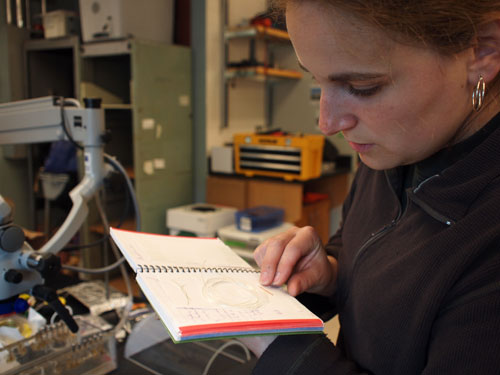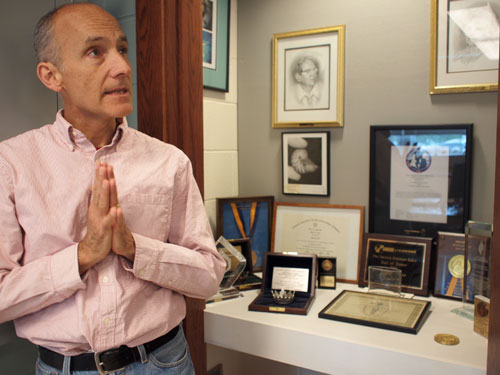A source of both constancy and continual change at the MBL is the Whitman Center for Research and Discovery. Every year, hundreds of researchers from other institutions migrate to the MBL (which they affectionately call “Woods Hole”) to rub elbows with colleagues from around the world, and collectively dive into an intense period of research. For some, their MBL stay lasts a few months, but for many, the relationship continues over years, decades or entire careers.
On Wednesday, a group of Whitman Center investigators gathered in the lobby of their “home away from home,” Rowe Laboratory, to celebrate the rich tradition of biological discovery that they are carrying into the future. MBL President and Director Gary Borisy noted that several of those in attendance wore a red carnation and a round lapel pin with the MBL’s double seahorse crest. These were Whitman investigators who have had a laboratory at MBL for the past 20 years or more. “You cannot buy this pin at any price! This is a precious pin, the MBL pin,” Borisy said, laughing, but most of those gathered would agree.

The leadership of the Whitman Center (from left): Gary Borisy, MBL; Joan Ruderman, Harvard Medical School; Peter Armstrong, University of California-Davis; Bob Goldman, Northwestern University. Photo by Beth Armstrong
Bob Goldman of Northwestern University, director of the Whitman Center, said he has been coming to the MBL since 1963, and that is what “turned me on to becoming a cell biologist.” Joan Ruderman of Harvard Medical School, who is speaker of the MBL Corporation, said she first came to the MBL as a student in the 1974 Embryology course and “it changed my life.” She then returned for many years as a Whitman investigator, when the program was conducted in the old Whitman Building. Eventually, she said, building renovations were necessary to stay abreast of advances in cell research technologies, and she applauded the $18 million transformation of Whitman to the cutting-edge Rowe Laboratory in the mid-2000s.
Yet one person in the crowd topped everyone with his MBL “stripes.” Peter Armstrong of University of California-Davis, who studies immunity in the horseshoe crab, said he “may have been conceived in Woods Hole in 1938.” (Peter’s father, Philip, was a researcher and later director of the MBL from 1950-1965, and he secured the federal funds to have the original Whitman Building constructed.) Peter’s early years as “an MBL brat” aside, he has been a principal investigator in the Whitman Center since 1975, “and its been an enormously successful place to be,” he said. “Half of my publications list the MBL as a place where the research was conducted.”
Borisy also recognized several Whitman investigators who, in the past, had laboratories for two decades and more. To conclude, Borisy announced the establishment of a $2 million Whitman Endowment fundraising initiative, with an initial $500,000 matching commitment from MBL. This endowment will support two strategies: continuous building enhancements to maintain Rowe Laboratory as a state-of-the-art facility, and fellowship funds to continue to bring the world’s best researchers into the Whitman Center fold.
“The Whitman Center is a critical part of the MBL,” Borisy said. “It is a crossroads, a place where scientific ideas germinate and are tried out. The MBL will celebrate its 125th anniversary in 2013, and since its very first year it has been a nexus for the world’s biologists. We aim to solidify support for the Whitman Center for the next 125 years.”

Some of the more than 200 Whitman investigators in 2011 gather on the steps of Lillie Laboratory. Those wearing red carnations have had a Whitman lab for the past 20 years or more. Photo by Beth Armstrong


























